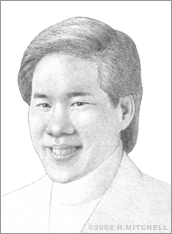Eugene Chan
When Eugene Chan was a 23-year-old medical school student, he came up with an idea for mapping a genome quickly and inexpensively — by mimicking the way DNA naturally acts when it duplicates itself.
While the DNA of any two people is nearly 100 percent identical, their genomes differ in subtle, myriad ways. These variations are what determine an individual's specific characteristics, such as eye color, hair color, and predisposition to disease. Mapping the human genome, however, is a tedious, difficult process that took scientists working on the Human Genome Project years to complete, and even then, only in fragments. Chan wanted to create a technology that would "speed-read" human genomes completely and then enable scientists to "read" that information quickly.
Chan earned a bachelor's degree from Harvard University, graduating summa cum laude. He was enrolled as a graduate student in the joint Harvard/Massachusetts Institute of Technology (MIT) MD Health Sciences and Technology Program when he first had his genome mapping idea. He became obsessed with developing a device that would make his vision a reality, even turning down offers to go out with friends to work on his theory. He realized fairly quickly that there was a real need for such a device among the medical and scientific community. He decided to concentrate on it full time, and in 1998, he founded a company, U.S. Genomics, with his brother Ian.
Eugene was chairman and CEO and Ian was CFO and vice president of corporate development for the company until 2003, when the board decided to change focus from DNA sequencing to the development of instruments used in single-molecule analysis. At this same time, the company changed its name to PathoGenetix. The brothers founded Abpro Corp. in 2007, which is focused on producing recombinant proteins to use in life sciences experiments.
Before they stepped down from their company, the Chan brothers raised $25 million in venture capital to found the company, which they set up to develop the "Gene Machine". Eugene received U.S. patent 6,355,420 for the device in 2002. His technology employs a blend of nanotechnology, microbiology, and information technology in a chip that allows for the manipulation and control of DNA. Basically, the chip contains fluid channels that stretch out the DNA. Scientists can read it with optical technology that U.S. Genomics developed, which is similar to the technology used to look at distant stars.
Chan's technology and others like it have raised an ethical debate around the world. Ethicists must continue to debate the issue of discrimination by health insurers, for example, so they can be ready to make rules once genetic determination becomes mainstream. Chan has insisted that he will work on creating "built-in safeguards that will prevent misuse, a lock-and-key mechanism for health-care providers to access the technology." He hopes his Gene Machines will one day enable doctors to customize drugs for people with different genetic makeups for better, more effective treatment with fewer side effects. He also hopes to begin working on bioinformatics, or systems to handle the massive amounts of data retrieved by his machines.


